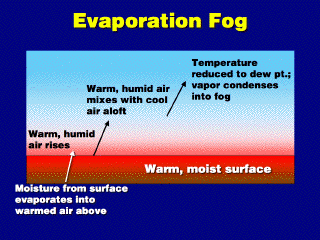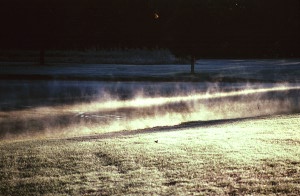 The warm moist surface is usually a warm body of water, though it may be the
wet ground or other wet surface, heated by the sun. In Southern California,
more often than not, it is a heated swimming pool (!). Indoors, a hot cup of
coffee, bowl of soup, or boiling pot of water can act as a warm, moist surface.
The warm moist surface is usually a warm body of water, though it may be the
wet ground or other wet surface, heated by the sun. In Southern California,
more often than not, it is a heated swimming pool (!). Indoors, a hot cup of
coffee, bowl of soup, or boiling pot of water can act as a warm, moist surface.
The air in contact with the warm,
moist surface heats up by conduction; it also becomes humidified by water evaporating
from the surface (that's why it won't work as well if the surface is dry). This
warm air is more buoyant than the cooler air above, so it tends to rise upward
and mix with the colder air. The cold air mixing in lowers the temperature of
the humid air, and can form fog droplets if the cooling is sufficient. The alternate
name "steam fog" comes from the fog's appearance as rising "steam".
If there is a wind, the "steam" is blown off so it looks like the
wind is what's forming fog (so you must evaluate the conditions before calling
this evaporation or advection fog: is the surface cool, or is it warm and moist?).
Notice that the foggy region does
not start until a short distance above the warm surface---close to the surface,
the air is still too hot to form condensation. This is most easily observed
by looking at the steam forming above boiling water.



 The warm moist surface is usually a warm body of water, though it may be the
wet ground or other wet surface, heated by the sun. In Southern California,
more often than not, it is a heated swimming pool (!). Indoors, a hot cup of
coffee, bowl of soup, or boiling pot of water can act as a warm, moist surface.
The warm moist surface is usually a warm body of water, though it may be the
wet ground or other wet surface, heated by the sun. In Southern California,
more often than not, it is a heated swimming pool (!). Indoors, a hot cup of
coffee, bowl of soup, or boiling pot of water can act as a warm, moist surface.